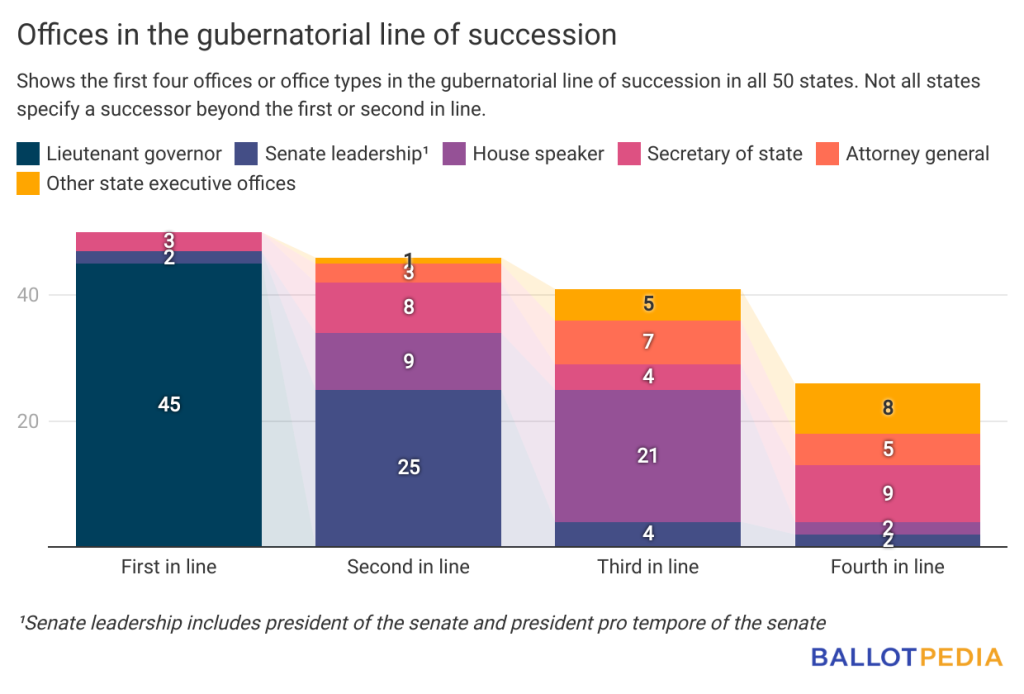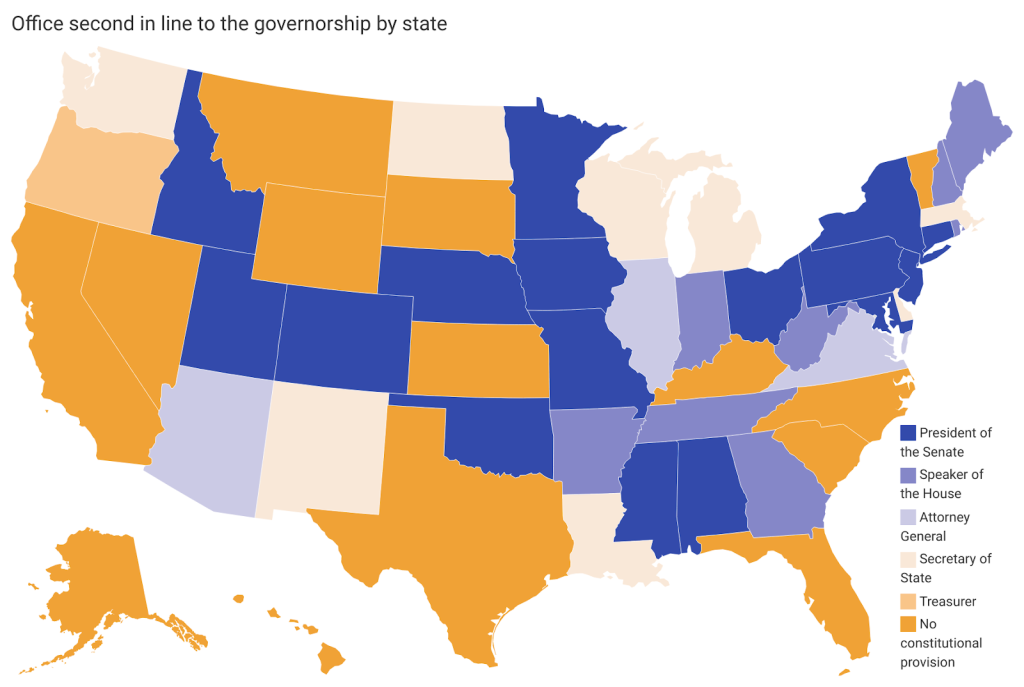Welcome to the Friday, March 31, Brew.
Here’s what’s in store for you as you start your day:
- In five states, the state superintendent of schools is included in the gubernatorial line of succession
- U.S. Sen. Dick Durbin becomes Paul Vallas’ first congressional endorsement in Chicago mayoral runoff
- #FridayTrivia: How many bills related to voter identification are we tracking so far this year?
In five states, the state superintendent of schools is included in the gubernatorial line of succession
On March 16, the Indiana Senate voted to refer a constitutional amendment to the November 2024 ballot that would remove the superintendent of public instruction from the gubernatorial line of succession.
The superintendent of public instruction is sixth—and last—in Indiana’s gubernatorial line of succession, following the secretary of state, the state auditor, the state treasurer, the speaker of the House of Representatives, and the president pro tem of the State Senate.
That got us thinking—how many other states include the state superintendent of schools in the gubernatorial line of succession?
The answer is five —Arizona, North Carolina, Oklahoma, Washington, and of course, Indiana.
None of those states put the superintendent near the front of the line of succession. In Arizona, the superintendent is fourth, while the superintendent is sixth in North Carolina. In Oklahoma, the superintendent is seventh, and in Washington the superintendent is sixth.
Here’s who comes first in the gubernatorial line of succession across the country:
- In the 45 states with a lieutenant governor, that individual is the first in the line of succession. That includes West Virginia and Tennessee, where the state Senate presidents serve as lieutenant governor ex officio.
- In Maine and New Hampshire, the president of the state senate is first in line to succeed the governor.
- In Arizona, Oregon, and Wyoming, the secretary of state is first in line to succeed the governor.

Things become more complex and varied when we move into the officers designated to succeed the governor if the first in line is, for some reason, unavailable to do so. Officers include the president pro tempore of the Senate, the president of Senate, the speaker of the House, the secretary of state, and the attorney general.

In South Dakota, Alaska, California, Kentucky, Nevada, North Carolina, South Carolina, and Wyoming, the constitution does not designate a second in line for the governor’s office, though successors may be specified in state statutes.
In Texas, unlike every other state, the chief justices of the 14 Courts of Appeals are included in the line of succession, following the attorney general, who is fourth in line. The courts are numbered (“Texas First District Court of Appeals,” “Texas Second District Court of Appeals,” etc.), and the line of succession runs in the numerical order of the courts.
Simple majorities are required in both the state House and Senate in two successive legislative sessions to put constitutional amendments on the ballot in Indiana.
The constitutional amendment to remove the superintendent from the line of succession was first introduced in the 2022 legislative session as House Joint Resolution 3. It passed the House 87-6 and the Senate 46-1. Lawmakers approved the amendment again in the 2023 session as House Joint Resolution 1. The House voted 99-0 to approve the measure on Jan. 31 and the Senate approved it 47-0 (with three members absent) on March 16.
Since 1996, the Indiana Legislature has referred 12 constitutional amendments to the statewide ballots. Voters approved all of them. The measures appeared on the ballot in 1996, 1998, 2000, 2004, 2010, 2016, and, most recently, in 2018.
Click here to read more about the gubernatorial line of succession. Click the link below to read more about the Indiana Remove Superintendent of Public Instruction from Gubernatorial Line of Succession Amendment.
U.S. Sen. Dick Durbin becomes Paul Vallas’ first congressional endorsement in Chicago mayoral runoff
On April 4, Chicago voters will choose between Brandon Johnson and Paul Vallas in the city’s mayoral runoff. Johnson and Vallas advanced from a field of nine candidates in the Feb. 28 general election.
Let’s take a look at some recent election news from the Windy City.
On March 26, U.S. Sen. Dick Durbin (D-Ill.) endorsed Vallas. In a news release, Durbin said: “Paul Vallas is a lifelong Democrat whom I have worked with for many years. He is a thoughtful leader who can strengthen Chicago’s economy and create jobs. He will be a mayor for all of Chicago and will move the city forward.”
Durbin was first elected to the U.S. Senate in 1997.
Several members of Congress have weighed in on the mayoral election, though Durbin is the first to back Vallas. Eleven members, including U.S. Sens. Bernie Sanders (I-Vt.) and Elizabeth Warren (D-Mass.), have endorsed Johnson. Four members of the Illinois House delegation also endorsed Johnson—Jonathan Jackson (District 1), Delia Ramirez (District 3), Danny Davis (District 7), and Jan Schakowsky (District 9).
The state’s other U.S. Senator, Tammy Duckworth (D), endorsed Mayor Lori Lightfoot in the first round and has not endorsed in the runoff. Lightfoot finished third in the general election.
Aside from Durbin, here’s a list of other recent endorsements:
March 28:
- General election candidate Ald. Sophia King endorsed Vallas.
March 23:
- Former Cook County Clerk David Orr endorsed Johnson.
- Former U.S. Secretary of Education Arne Duncan (D) and Ald. Roberto Maldonado endorsed Vallas. Click here for a lengthier look at where Vallas and Johnson stand on education from a recent issue of Hall Pass, our weekly education newsletter.
March 22:
- U.S. Rep. Ayanna Pressley (D-Mass.) endorsed Johnson.
- Former Gov. Pat Quinn (D) endorsed Vallas. Quinn endorsed Jesus Garcia in the general election.
March 21:
- U.S. Reps. Brendan Boyle (D-Pa.) and Troy Carter (D-La.) endorsed Johnson.
- Former U.S. Rep. Bobby Rush (D) endorsed Vallas.
Click here to see more endorsements in the race.
Vallas received 33.7% of the vote in the general election. He was the 2014 Democratic nominee for lieutenant governor. Vallas worked as chief administrative officer at Chicago State University and was the CEO of Chicago Public Schools.
Johnson received 20.3% of the vote in the general election. He was elected to the Cook County Board of Commissioners as a Democrat in 2018. Johnson was a teacher with Chicago Public Schools and an organizer with the Chicago Teachers Union (CTU).
Although elections are officially nonpartisan, candidates are typically affiliated with one of the major political parties. Both Johnson and Vallas are Democrats. The last Republican mayor of Chicago, William Thompson, left office in 1931.
Click the link below to learn more about Chicago’s mayoral runoff.
#FridayTrivia: How many bills related to voter identification are we tracking so far this year?
In the Monday Brew, we gave you a rundown of election administration bills in three states that were signed into law last week. One of those states was Idaho, where Gov. Brad Little (R) signed H0124, removing student IDs from the state’s list of acceptable forms of voter identification.
How many bills related to voter identification did we say we’re tracking so far this year (Hint: you can use our Legislation Tracker to filter by topic to find the correct number).

